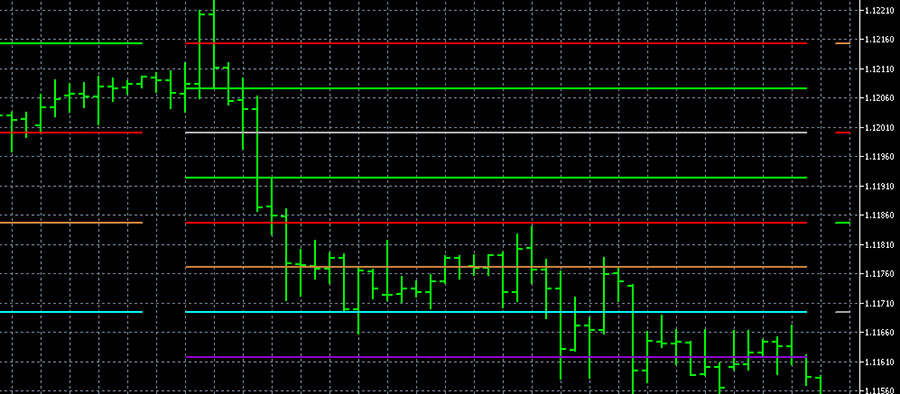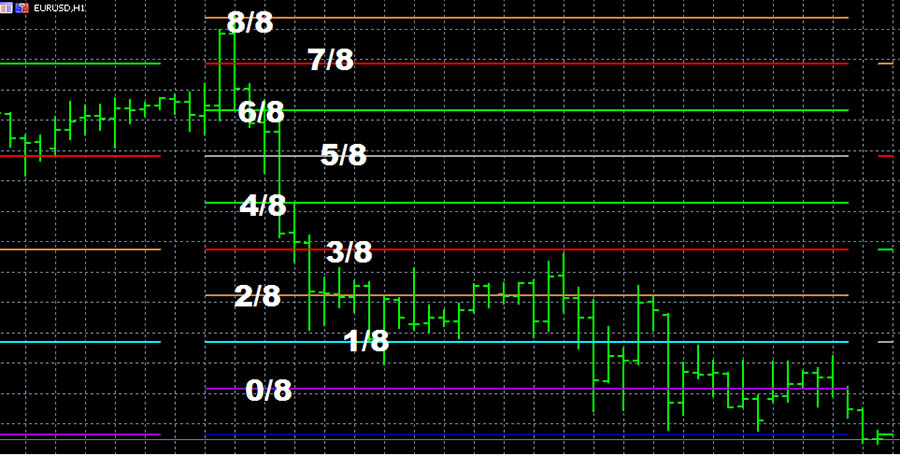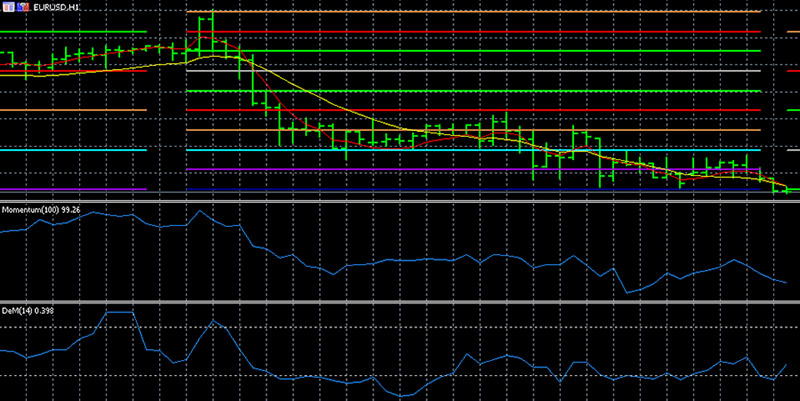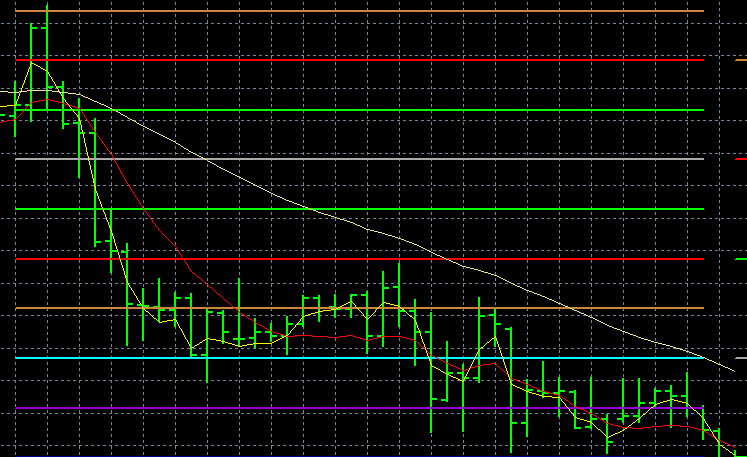Murray Levels Indicator
Contents
Murray Levels Indicator Description
The Murray indicator (fig. 1) was created based on the theory of William Gann, the famous American trader of the beginning of the 20th century. The key elements of Gann’s theory are model (set of repeating elements), price and time. The theory was realized in the prognostic elaboration “The Square of Nine”, which was used by Thomas Murray. At the same time Murray used the developments of famous traders Williams and Demark.
This indicator allows you to identify significant support and resistance levels on the price chart, identifies extremums and intermediate levels, the best points to enter the market and exit points forex trading. The indicator is primarily used by traders working on a breakout and rebound.
Murray highlighted several basic principles of working with the indicator of his name:
- A spike in sales volume marks the last phase of an uptrend and heralds a reversal of the trend.
- If the price breaks through the corridor after the second extremum and goes into a flat, it indicates the dominance of the “bears”.
- If after the fall of the price there is a decrease in volumes, we should expect the resumption of the “bullish” trend.
- If the pullback is insignificant when reversing to an uptrend and continues to rise after the correction, it indicates the beginning of a strong bullish trend.
It is believed that the optimal timeframe to work on the Murray levels is H1. Indicator for forex shows better results during the movements of pronounced trends. But it is preferable to use Murray levels with additional oscillators for forex and tools that are based on cyclical and wave market theory – FibonacciElliott waves and so on.
Murray levels effectively show strong reversal zones and signals of this indicator are considered more reliable in this direction than signals of other instruments. Plus, traders should familiarize themselves with the basics of Gann theory and fractal price theory before using the Murray indicator – Murray uses this type of scaling in his indicator.
Log in to your broker’s terminal, add the Murray levels indicator to the chart and see what comes out
| Broker | Bonuses | Open an account |
|---|---|---|
|
1
|
50 %
Bonus on deposit from $100 USD – promo code WELCOME50
|
Start |
|
2
|
From 25 To 60 %
Deposit increase for the first deposit
|
Start |
|
3
|
Cashback
Refunds of commissions, spreads and other costs
|
Start |
|
4
|
100 USD
Loyalty program remuneration
|
Start |
|
5
|
20 %
Bonus and cashback by promo code revieweek23
|
Start |
The Murray levels indicator in the MetaTrader 5 platform
The Murray levels indicator is not standard for trading terminals, it must be installed in the MT5 platform. For example, at this link you can download the boot file. Then, in the “File” section of the terminal, subsection “Open directory”, through the process “Compile” download the file in the navigation bar on the left. From the settings of the indicator the value is “Calculation period”:
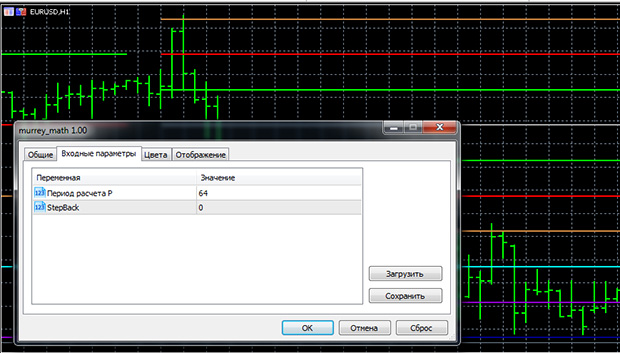
When placing the indicator on the graphic it is necessary to take into account its theoretical foundations. In the Gann theory the price movement was divided by 8, the standard period of the indicator, respectively, is 64 (Fig. 3). In order to get a sufficient range width on the chart and the lines are lined up as they should be, it is necessary to select the values divisible by 8 empirically.
The vertical dimension of the Gann square, on which the indicator is built, determines the price. The horizontal dimension is calculated by rounding the number of trading days in a year to 256, we get 4 quarters of 64 days. This arrangement is optimal for scaling calculations. The indicator can also be applied to other periods. The longer the period, the more responsive Murray’s lines are, but a greater period works effectively on timeframes of a day or more. A lot of false signals are generated for smaller periods.
Signals of the Murray levels indicator
The Murray levels indicator is based on the 8×8 Gann square, which is positioned relative to the beginning and end of the trend movement. The price forecast analyzes the angles of the movement in relation to the trend, the angle 45% shows a strong movement. According to Gann theory a strong price movement is followed by a breakout or pullback to one of nine levels. According to Gann theory, the correction 50% from extremums is the most informative one.
Murray proposed a system of lines, the so-called “Octave” (Fig. 2): 0/8, 1/8, 2/8, 3/8, 4/8, 5/8, 6/8, 7/8, 8/8. The levels are unequal; Murray distinguished more and less strong among them:
The boundaries of the 8/8+0/8 range are considered to be very strong lines. The levels represent support and resistanceIn this case, a pullback from 0/8 to the upside is more probable than a pullback from 8/8, but a breakdown occurs more often at this level. The trader should be especially attentive at these levels, as the trend can change very quickly.
The 7/8 and 1/8 levels are weak and usually the trend quickly crosses them and goes to higher levels, such as 8/8 + 0/8 or 4/8. But sometimes the 7/8 and 1/8 levels can also cause a correction.
The central line is the 4/8, it is a strong line, it can be the main line for opening positions. In this case, if the price is above the level, the line serves as support. If the price is below the level, the 4/8 line becomes resistance. It has also been noticed that the price may fluctuate near this line for a long time before it breaks through. At the same time there may be a lot of false breakdowns at this level.
The trend, reaching the 2/8 and 6/8 levels, often corrects or even reverses, these levels represent strong resistance.
The 3/8 and 5/8 lines often act as a range for a long sideways trend. Within these boundaries, price fluctuates over 40% time. It is believed that if the trend has broken through this zone, it is likely to move further, not back. That said, if the price stays at these levels for a long time, it is advisable to open a position in the opposite direction from the line. If the trend is above or below the lines, then most likely we should expect the formation of a new trend in the forex market (The whole truth about forex).
Strong support and resistance levels are the -1/8 and +1/8 lines. Often the price bounces from the boundaries of this range and returns to the current trend. But if the price breaks through, it is likely that a new trend is formed. After crossing the -2/8 and +2/8 lines all the levels of the indicator are rearranged according to the local extrema.
By the way, the area from levels 8/8 to +2/8 is an overbought zone, and the levels from 0/8 to -2/8 is an oversold zone.
When analyzing the market situation, it is recommended to analyze the long timeframes. The most accurate confirmations are in the 0/8 or 8/8 ranges. Forex Signals indicator – movements above 5/8 or below ⅜. When applying the Murray levels, you should keep in mind that they react weakly to rapid movements, it is optimal to use this indicator in a stable market. It is not recommended to trade on levels against the trend.
When using the Murray levels, a preliminary analysis of the situation should be done on the higher timeframes, the lower timeframes are needed to confirm entry points into the market (forex analytics). The advantage of the indicator in question is that it clearly shows the most important price channels, allows you to more accurately determine goals and set stop-losses.
Trading strategies based on the Murray indicator
The Murray indicator is visually complicated, takes time to set up and scares many people away, so it is used less often than it deserves. Nevertheless, there are quite a few Forex strategiesThe following table shows the results of the analysis of the indicators and the results of the analysis.
One of them uses, in addition to Murray levels, exponential moving averages on closing prices: EMA with a period of 9 and the EMA with a period of 31; Momentum with a level of 100 and Demark indicator (Fig. 4).
Recall that the Demark indicator shows overbought and oversold conditions, divergences, signals for breaking through resistance and support levels. In this strategy, the Demark indicator is needed to determine the trend lines and as a target indicator. The strategy is implemented on any asset, preferably traded on a timeframe above H1. It is optimal to implement it on stable, pronounced trends.
A buy signal will be when the EMA (9) crosses the moving average EMA (31) from bottom to top, the price breaks the Demark line and the Momentum should be above the 100 level. The Murray indicator should show a price above the 2/8, 4/8 or 6/8 lines, confirming an uptrend.
The signal to sell would be if the EMA (9) crosses the moving average EMA (31) from the top down, the price breaks the Demark line, the Momentum is below the 100 level, the Murray indicator should be below the 8/8, 6/8 or 4/8 levels.
The Murray levels strategy most often involves trading on a bounce. Such signals often occur at levels 1/8 and 7/8 after levels have already been unsuccessfully tested. The trend-firming signals occur after the consolidation phase at some level. Trading on the channel breakdown is optimal at the 3/8 and 5/8 levels. But a strategy based only on Murray levels requires a fairly thorough understanding of the market.
The author of the indicator suggested the strategy of working with moving averages with periods of 5, 20, 50 and 89 (Fig. 5).
In this strategy, if the EMAs are lined up on the chart and the prices are above the 4/8 level, this is considered a buy signal. If the EMAs are placed in the order of 20, 5, 50, 89, it is considered as a signal to sell. The order in which the EMAs 50, 20, 5 and 89 are also a signal to sell. However, you should monitor the price movement in order to timely place a buy order.
Murray levels can be supplemented with Zigzag indicator. This indicator is designed to highlight the highest or lowest values on the chart, which it connects directly with lines, thus cutting off insignificant fluctuations. The strategy with Murray levels is implemented on timeframes from H4 and above.
Trading is done from the extremums marked by the Zigzag indicator, if one of the Murray levels shows a breakout. If you add a commodity channel oscillator to this strategy CCIThe CCI will confirm the signals of the Murray indicator. In this case, the signal to buy will be the exit of the CCI curve from the -250 area, breaking through the level of -100, while the Murray indicator fixes the rebound at the 1/8 line.
Conclusions
Murray levels are quite an effective trading tool, but it is quite difficult to master, so it is sometimes underestimated by traders (Forex Trading Training). The indicator accurately enough defines support and resistance, identifies consolidation zones, gives clear reversal signals. If you become more familiar with the tool, it can significantly improve your trading results.
However, it is desirable to apply the indicator of Murray levels in optimal conditions – in a stable market and at appropriate timeframes, with additional indicators, and also to have sufficient trading experience in the market no risk forex. Although there are also simplified strategies with this indicator.
